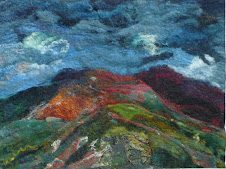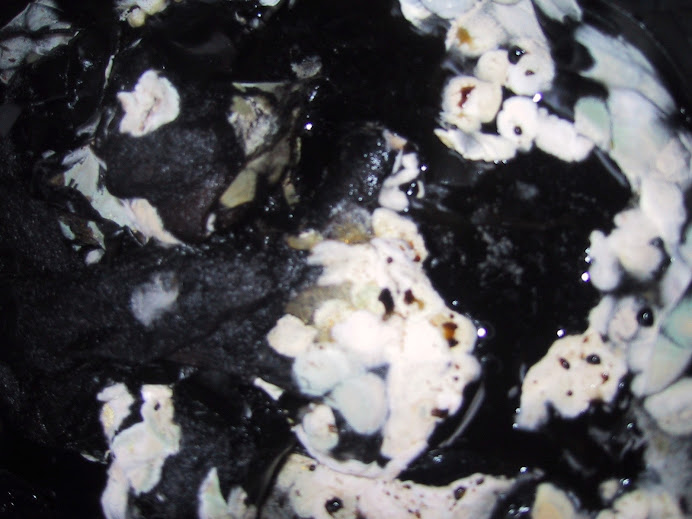This is really there for myself to clarify my thoughts but if you can make head or tail of it do make comments.
According to the information Michael Garcia gave us at ISEND this is a vat that should works so today I decided to have a go.
For some mad reason I mixed 25 g of natural indigo into a paste-I should have mixed up 10 g.
I started at 12 noon
I put about 6 litres into a small stainless steel pot at 50 degrees and 1 tablespoon of calcium hydroxide . This gave a pH of 10-11. I know Michael started off with a high pH
I also heated the vat as I think he started off with a hot vat and cooled it .
I added 2 tablespoons of fructose
1pm.
After an hour the vat showed signs of slight reduction but dyed some cotton a very peculiar green .
The temperature rose to 65 degrees but the smell of a vat coming into order went and it had an odd smell. The vat looked milky with grains of undissolved indigo on the surface.
by 3pm
I tried removing some of the vat and adding thiourea dioxide which reduced the vat very quickly and dyed a sample a nice blue so I knew the vat was okay I just need to make the fructose work,.
Indigo grains had disappeared there was film on the surface but the ph dropped to 8-9.
a piece of cotton dyed a very pale blue. Hooray I thought I am cracking it!
I left it for a bit and went back but the pH had dropped further to pH7
At 5.30 I added 1 tablespoon of calcium hydroxide. I added 75g of fructose , there was a film on the surface the vat looked a slightly murky yellow and gas was coming off the surface. I dyed some cotton a very pale blue and some linen a patchy green with some very pale patches.
However then the vat seemed to go off.
I finally upended the remainder of the fructose into the vat so I had altogether added 250g (meaning all this was very expensive vat) and left some linen in. This dyed a dark green oxidizing in the air but not to a full blue.
hmm!
I am puzzled.
According to the information Michael Garcia gave us at ISEND this is a vat that should works so today I decided to have a go.
For some mad reason I mixed 25 g of natural indigo into a paste-I should have mixed up 10 g.
I started at 12 noon
I put about 6 litres into a small stainless steel pot at 50 degrees and 1 tablespoon of calcium hydroxide . This gave a pH of 10-11. I know Michael started off with a high pH
I also heated the vat as I think he started off with a hot vat and cooled it .
I added 2 tablespoons of fructose
1pm.
After an hour the vat showed signs of slight reduction but dyed some cotton a very peculiar green .
The temperature rose to 65 degrees but the smell of a vat coming into order went and it had an odd smell. The vat looked milky with grains of undissolved indigo on the surface.
by 3pm
I tried removing some of the vat and adding thiourea dioxide which reduced the vat very quickly and dyed a sample a nice blue so I knew the vat was okay I just need to make the fructose work,.
Indigo grains had disappeared there was film on the surface but the ph dropped to 8-9.
a piece of cotton dyed a very pale blue. Hooray I thought I am cracking it!
I left it for a bit and went back but the pH had dropped further to pH7
At 5.30 I added 1 tablespoon of calcium hydroxide. I added 75g of fructose , there was a film on the surface the vat looked a slightly murky yellow and gas was coming off the surface. I dyed some cotton a very pale blue and some linen a patchy green with some very pale patches.
However then the vat seemed to go off.
I finally upended the remainder of the fructose into the vat so I had altogether added 250g (meaning all this was very expensive vat) and left some linen in. This dyed a dark green oxidizing in the air but not to a full blue.
hmm!
I am puzzled.



























This is interesting, thanks for posting it.
ReplyDeleteIs the fructose supposed to reduce the vat in one day?
I would have to try it, too, because I have trouble keeping the temp high for days.
Hi Leena
ReplyDeleteMichael seemed to reduce his vat in 15minutes. It is not a fermented vat but a standard reduction vat just using fructose instead thiourea dioxide.
Really! That would be good to know how to do it.
ReplyDeletePlease keep us posted how it goes:)
Puzzling, yet tenacious...good experimenting and some success thrown in for a bonus. Good work and do let us know how it goes.
ReplyDeleteThis indigo bath circled in my mind all day yesterday, what if you made a smaller stock solution first, perhaps it would reduce then? Like the chemical vat works better if you make the stock solution first, so it would have even higer pH. I'm going to try it, too as soon as I figure out what fructose would be in Finnish (and where to get it in Finland) or could there be another source of suger that would work. Why not ordinary sugar?
ReplyDeleteHI Leena good thinking! Thanks
ReplyDeleteFructose is fruit sugar. apparently that and glucose works but not sucrose ( ordinary sugar)
The other thing that was frequently said to me at ISEND was to make up the vats in 1:2:3 ratio. So for 10 g indigo use 20 g calcium hydroxide and 30g of fructose. However to my mind this all depends on how much water you have,. If you put 20g of calcium hydroxide into 1 litre you get a different pH to what you would get if you put it into 5 litres. So this ratio does not make sense to me. Anyway I am going to try your suggestion and make up a small concentrated vat. :)
I was very keen about this when Ulrike told me about it! but it doesn't seem quite as straightforward as it sounded, reading about your problems here:)) maybe I'll let you try it out a bit more first:)) if glucose works as well that would be tempting, because I can get that in the shops (not fructose though:(().... it was difficult enough to find out which lime is sold in the builder's yard and whether it's suitable or not:))
ReplyDeleteHi Bettina. I was very keen on it! I thought it would be a doddle but no such luck . I have made a fully reduced tiny vat now and will blog about it but can't scale it up to a big vat.
ReplyDeleteHi Helen, do you think the tiny reduced vat wouldn't work if you put it to a bigger pot like you do when you make stock solution for chemical vat? It could of course oxydize when you put it to bigger bat and then what..
ReplyDeleteWell, a smaller vat was just what I used today and it worked well. Not got any really dark blues but that might be because I was so convinced it wouldn't work I didn't put as much effort into preparation of materials as I might have! Anyway, it's on my blog, Caterpillars and Cocoons - my vat is considerabley smaller than Michel's, I think
ReplyDeleteI will go tomorrow to buy fructose and try this also.
ReplyDeleteHere is one link to Anne Vuoremas thesis https://www.doria.fi/bitstream/handle/10024/42825/AI388%20Vuorema.pdf?sequence=1
look page 51 ANTHRAQUINONE CATALYSED REDUCTION OF INDIGO WITH
GLUCOSE
It is difficult to read, too technical, but in the end of that chapter there are interesting things about reducing indigo with glucose.
Hi Janes mine is small 400m but it worked and sit still working but I need to work out how to scale up.Thanks Leena for the link.
ReplyDelete